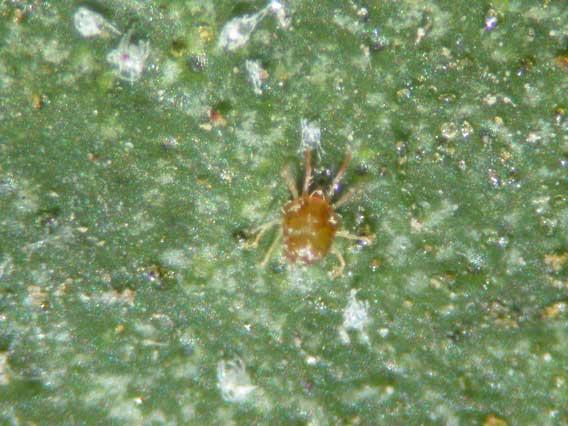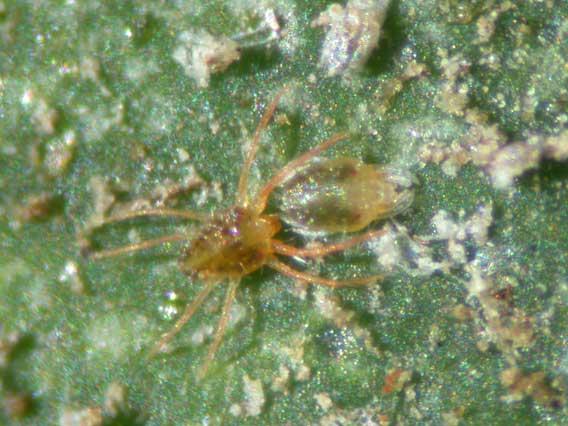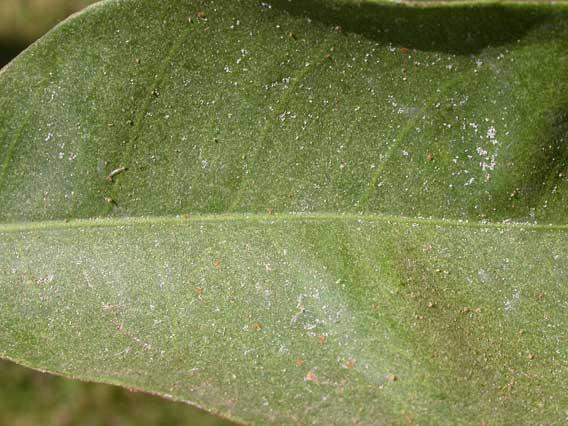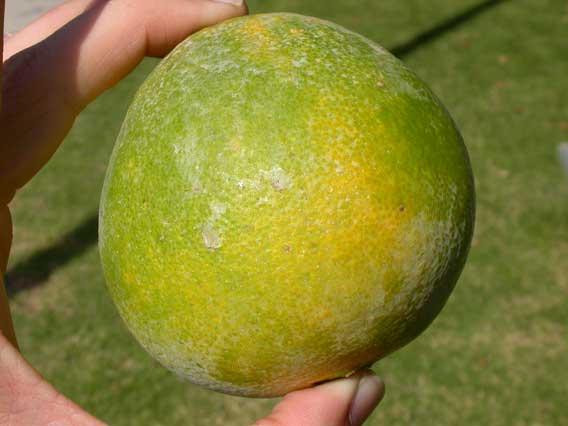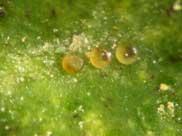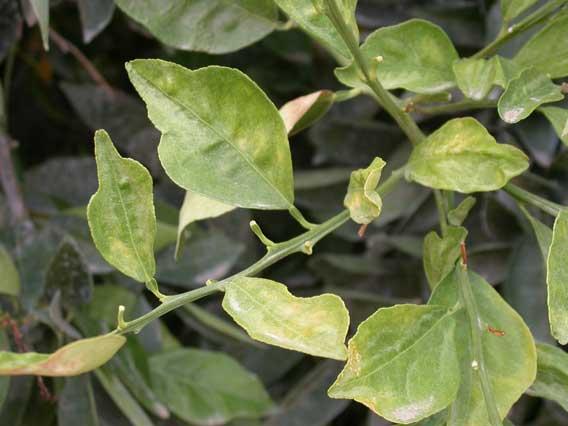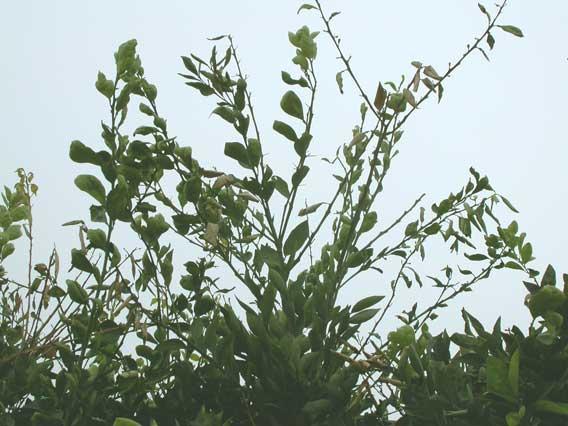Texas citrus mite, a new pest of San Joaquin Valley citrus
Texas citrus mite, a new mite pest of San Joaquin Valley citrus, has recently been identified from widespread regions in Kern County. High densities of this pest have been associated with leaf drop, and uncertainties regarding the severity of this pest have led to fall miticide applications in some of Kern County's blocks of citrus.
Description and Distribution
Texas citrus mite, Eutetranychus banksi, is a long-established pest of Florida and Texas citrus. It is a large spider mite, and is visible to the naked eye. Adult females and nymphal stages are oval, brownish-green, and have irregular dark green spots near the side of the body. Compared to the females, the adult males are more triangular in shape, have smaller bodies, and have much longer tan-colored legs. When feeding on a leaf, these legs are characteristically placed straight forward and straight backward parallel to the leaf surface. In California, Texas Citrus Mite was first reported to the California Department of Food and Agriculture in 1990 from blocks of grapefruits and tangerines in the Mecca region of the Coachella Valley. It was also reported from the Fillmore region of Ventura County in 2000. There are no other official records of this pest throughout the state.This year in Kern County, growers have found high numbers of this pest in the Edison/Bena Road area, General Beale area, and in the Maricopa flats area along Highway 166. It has also been observed farther to the north in the Belridge area, where one PCA noted that this is the third year that he has seen this pest. In previous years the numbers so few that pesticide controls were never needed.
Damage
Texas citrus mite is almost exclusively found on the upper surface of the leaves, where they tend to be most numerous near the mid-rib. Infested leaves can be quickly identified due to the pale stipple marks made through the mites' feeding efforts. High densities of this pest and the associated leaf stippling results in leaf drop. Excessive leaf drop is of concern, as it can potentially lead to sunburn and or fruit drop. Under high density conditions, mites will also feed on and cause discoloration of fruit. While this is not a concern to processors, it can result in off grades for fresh market fruit.Life Cycle and Critical periods
The life cycle of Texas citrus mite is similar to that of other mites. Adult females place disc-like eggs singly on the top surface of the leaf, often near the mid-vein of the leaf. Eggs change from yellow to reddish-brown as they are near hatching. Once emerged from the egg, immature mites pass through larval, protonymph, and deutonymph stages before emerging as adults. The entire life cycle takes approximately three weeks under favorable conditions. According to Florida and Arizona newsletters, Texas citrus mite is of primary concern from February/March until May/June. After that, populations decline in Florida due to high humidity and rains, whereas they decline in Arizona due to excessive heat. Literature from Texas suggests that these pests reach their peak densities in the fall, when they can cause sever leaf discoloration and drop. Similar observations have been made in the Coachella Valley of California. One PCA from that region stated that this pest is at its worst during mild temperatures in the fall when it attacks green stems, as well as leaves, and that this feeding leads to rapid defoliation. He also noted that this pest does very well at 105°F, but dies off rapidly at 110°F, and that it does well in intermediate humidity. Densities in the Coachella Valley dwindle in cold wet weather at the end of the year.Management
Thresholds for Texas citrus mite in California are not well defined. In Florida, thresholds of 5-10 per leaf in the spring warrant treatments on processing citrus. These thresholds have little application to fall treatments of California's fresh-market fruit. In Arizona, guidelines suggest that chemical controls are only needed when large numbers of this pest are on the fruit.In general, defoliation in October and November in the San Joaquin Valley has not occurred until mite densities have reached 3 to 4 times the spring threshold for Florida. This fall in Kern County, trees have been identified with mite densities exceeding 150 mites per leaf on some individual leaves. In all cases with mites averaging over 35-50 per leaf, some leaf drop was present. In most cases, the first leaves to drop are those of the fall flush that are expendable, will freeze, or will be pruned off anyway.
Spider mites, including the Texas citrus mite, do well under dry, dusty conditions. Border trees near dirt roads commonly have the highest mite densities, and the most leaf drop. Watering roads, or driving more slowly on them, will help.
Texas citrus and other mites also reproduce more quickly on water-stressed trees. It is worth mentioning that the worst incidences of this pest this year were in mid- to late-October in blocks of early-maturing varieties in Kern County. This is the period when growers typically deficit irrigate their trees in an effort to bring up fruit sugars. It was also the period in 2003 that had warmer-than-normal temperatures. A combination of warm weather, deficit irrigation, and dust likely greatly influenced some of the worst outbreaks of this pest.
Most beneficial insects that feed on citrus red mite will also feed on Texas citrus mite. This includes lady beetles, lacewing larvae, and sixspotted thrips. It is unclear if predaceous mites, such as Euseius tularensis will also feed on this pest.
Several growers have sprayed blocks over the past month to avoid continued defoliation. Pyridaben (Nexter), dicofol (Kelthane), and fenbutatin oxide (Vendex,applied before cool weather set in) have all been effective. In addition to these products, literature from other states suggests that wettable sulfur and propargite (Omite) would also be effective. In the case where spring applications become warranted, oil applications or abamectin (Agri-Mek) used as a thrips spray may also be effective.

